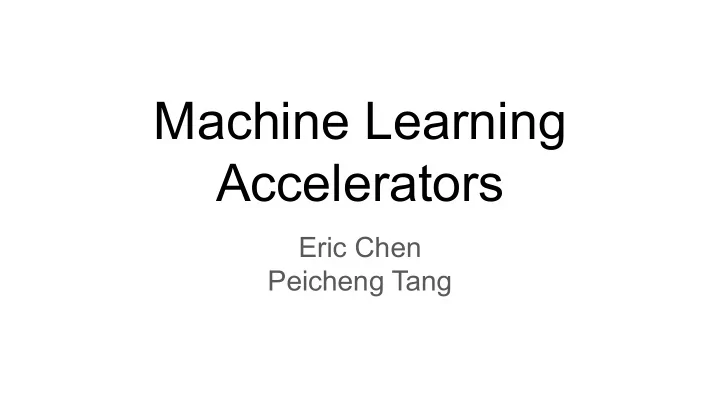

Machine Learning Accelerators Eric Chen Peicheng Tang
In-Datacenter Performance Analysis of a Tensor Processing Unit ● Motivation ● Background ● TPU Overview ● Benchmarks and Platforms ● Results (Performance) ● Results (Energy) ● Takeaways
Motivation ● Rapidly increasing computation demand on Google’s datacenters ● Neural networks are expensive to run on CPUs ● Solution: Develop and deploy an ASIC to accelerate NN inference
Background ● Artificial neurons ○ Nonlinear functions of the weighted sum of inputs ○ Classify data points into one of two kinds ● Performs the following calculations ○ Multiply the input data (x) with weights (w) to represent the signal strength ○ Add the results to aggregate the neuron’s state into a single value ○ Apply an activation function (f) to modulate the artificial neuron’s activity. Content referenced from: https://cloud.google.com/blog/products/gcp/understanding-neural-networks-with-tensorflow-playground https://cloud.google.com/blog/products/gcp/an-in-depth-look-at-googles-first-tensor-processing-unit-tpu
Neural Networks ● Collect neurons into layers ○ Output of one layer is input into the next ● Two Phases ○ Training ■ Use training datasets to learn the weights and bias ○ Inference ■ Running the network to perform classification ● Three common types: ○ Multi-Layer Perceptron (MLP) ○ Convolutional Neural Network (CNN) ○ Recurrent Neural Network (RNN) ■ LSTM is the most common RNN
Neural Networks cont. A very high level overview of inference tasks: ● Fetch inputs and weights ● Perform large-scale matrix multiplication ● Apply activation function on outputs ● Write data back to storage
TPU Overview ● Neural Network inference accelerator ● Coprocessor on PCIe bus ● CISC-based instruction set ● Instructions sent by server, no fetching ● Primary components: ○ Matrix Multiply Unit ○ Accumulators ○ Weight Memory and FIFO ○ Activation Unit ○ Unified Buffer ● Instructions are 4-stage pipelined ○ Keep matrix unit busy ○ Hide other instructions by overlapping execution with the matrix multiply
TPU Operation ● Fetch inputs and weights ○ Input data from CPU host memory -> buffer ○ Weights from weight memory -> FIFO ● Perform large-scale matrix multiplication ○ Pass inputs and weights through systolic array, output stored in accumulator ● Apply activation function on outputs ○ Store results in unified buffer ● Write data back to storage ○ Write back from buffer to host memory
Benchmarks and Platforms Workload Platforms
Results (Performance) ● Gap between data points and ceiling shows potential benefits of performance tuning ● Using weighted mean of workloads, TPU is 15.3x faster than GPU
Results (energy) ● 17-34x better total perf/watt over GPU ● 25-29x better incremental perf/watt over GPU ○ Incremental excludes host CPU power consumption
Energy Proportionality ● Servers are not always busy - ideally power should be proportional to workload ● Graph normalized per die, server has 2 CPUs and either 8 GPUs or 4 TPUs
Takeaways ● Memory bandwidth has the Performance Scaled w/ parameters greatest impact on perf. ○ 4/6 applications were memory bound ● CNNs are common on edge devices, but MLPs and LSTMs make up the bulk of datacenter workload ● Inferences per second is a poor metric ● History is important for designing domain-specific architectures
DaDianNao: A Machine-Learning Supercomputer ● Motivation ● Main Contribution ● Implementation details ● Evaluation
Motivation ● Neural Network has the trend to have larger size ○ Increasing number of parameters ○ 1 billion parameters(64bits/each) = 8GB ● Existing accelerators have size limitations ○ Only small neural network can be executed ○ Intermediate data (learned parameters, Main problem: synapses) stored in main memory ● Improve DianNao? Memory bandwidth/storage
Contribution DaDianNao----A multi-chip system that maps memory footprint to on-chip storage 1. Synapses are stored close to the neuron 2. Asymmetric architecture where each node footprint is massively biased towards storage rather than computations 3. Transfer neuron results instead of synapses (Low external bandwidth needed) 4. Break down local storage into tiles (High internal bandwidth)
Implementation Detail----Node 1. Synapses Close to Neurons a. Both inference and training b. Low energy/latency data transfers c. Use eDRAM to store data d. Split eDRAM into four banks 2. High Internal Bandwidth a. Tiled based design b. Tiles connected via fat tree
Implementation Detail----Node 3. Configurability (Layers, Inference vs. Training) ○ Pipeline configuration ○ Block: Aggregation of 16-bit operators i. 16 bits work most of time, but fail in training
Implementation Detail----Overall Characteristics
Implementation Detail Programming, Code Generation 1. Programming, Control and Code Generation
Implementation Detail Multi-Node Mapping 1. Multi-Node Mapping a. Convolutional and pooling layers b. Local response normalization layers c. Classifier layers
Evaluation - Performance With 64 nodes: Inference: outperforms a single GPU by up to 450.65x Training: 300.04x
Evaluation - Power With 64 nodes: Inference: reduce energy by up to 150.31x Training: 66.94x
Recommend
More recommend